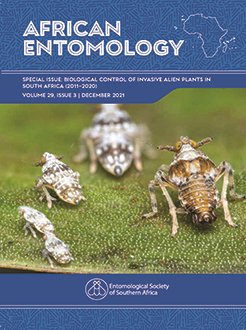Lantana camara L. ‘lantana’ continues to pose economic and ecological challenges in South Africa. The present review provides a brief overview of biological control (biocontrol) agents established in South Africa, including their combined impact and individual performance of four agents released during the recent past. In total, 16 biocontrol agents are fully established on lantana in South Africa, and three of these are either indigenous or inadvertently introduced into the country. Despite the establishment of these agents, biocontrol of lantana is not effectively reducing the density of the weed, particularly in the inland regions of the country. However, recent studies showed that biocontrol is causing a significant reduction in plant growth, biomass and seed production at various sites in the coastal region of KwaZulu-Natal (KZN) and the continental area of Mpumalanga province. The sap-sucking mirid Falconia intermedia has been observed to resurge at a number of sites following its crashing countrywide after its release in 1999. Falconia intermedia is, however, still confined to the warm low-lying regions of the country. The flower-galling mite Aceria lantanae has dispersed widely throughout South Africa and some neighbouring countries. The mite reduced flower production of susceptible varieties by up to 97% in the humid coast of KZN. Eleven years after its release, the root-feeding flea beetle Longitarsus bethae is still largely confined to the vicinity of its release sites, where it is severely damaging lantana. Although populations of the petiole weevil Coelocephalapion camarae collapsed at many sites following its release, the weevil has persisted for over 15 years at two isolated sites in KZN province. Efforts are being made to mass rear and redistribute L. bethae and C. camarae in order to improve their establishment and dispersal rate. To cope with varietal resistance and climatic extremes, attempts to find new strains of the existing and promising biocontrol agents are continuing. To justify the continued development of additional agents, the ecological and economic benefits of biocontrol should be assessed, particularly in the coastal region where biocontrol is more effective.
How to translate text using browser tools
31 December 2021
Current Status of Biological Control of Lantana camara L. (sensu lato) in South Africa
D.O. Simelane,
N. Katembo,
K.V. Mawela
ACCESS THE FULL ARTICLE
It is not available for individual sale.
This article is only available to subscribers.
It is not available for individual sale.
It is not available for individual sale.

African Entomology
Vol. 29 • No. 3
December 2021
Vol. 29 • No. 3
December 2021
biocontrol impact
climatic mismatch
coastal climate
continental climate
varietal resistance





